3 Russia and our Proposals
In this segment we will discuss Russia’s political, economic and cultural characteristics in order to get a clear overall picture of the state of the country. This information will then be used to suggest strategies of growth to Russia that have worked in Austria and should be implemented in their country too.
3.1 Politics, Economics and Culture
3.1.1 Politics
Russia is currently a sovereign socialist state within a federal structure. Before the 1980s the country was fully controlled by the Communist Party of the Soviet Union. Even though there were elections, all candidates were part of the same party. In 1980 things changed with the government of Mikhail Gorbachev who began a period of restructuring, opening and democratization that lasted until 1991. During this process, in 1988 the congress of the people’s deputies for each state is created and for the first time there are candidates from outside the Communist Party. In 1990 the Congress declared that Russian laws were above those of the Soviet Union and the Soviet Union became the Russian federation.
3.1.1.1 Constitutional Framework (1993)
The new constitution of 1993, shaped by Mikhail Gorbachev but led by Boris Yeltsin was not perfect by any means as there were still difficulties between the executive and the legislative branches in deciding what the aim of the political and economic reforms should be. The 1993 constitution had four main changes: (1) The president could not govern for more than two consecutive periods, (2) the president is democratically elected, (3) the president has the power to choose the Prime Minister and (4) the president is the leader of the armed forces. In 2008, under the government of Vladimir Putin, the presidency period was increased form 4 to 6 years. The 1993 constitution presented a great advance in terms of development as it ensured Protection of well-being, social security, pensions, free health care and local laws.
3.1.1.2 Regional and local government
The Russian Federation is composed of regions and districts, who’s number and frontiers have changed over time. These regions, as established in the 1993 constitution had the power to set their own policies (although these policies could not trump federal ones). In 2000 Putin created seven ** districts **, whose level was above regions to reduce their power and claim it his. In 2010 an eight district was created, followed by the annexation of Crimea from Ukraine which was given a district distinction.
With the creation of the district system, the president was supposed to be a guide the district rulers, but in reality he turned to commands them. Compared to the general government, regional governments usually do not have enough tax revenues and find it difficult to pay even schools and police. They also have ** pension overload ** problems.
In current times Putin has created laws that increasingly take away power from regional rulers and give it to the federal government. As an example, the 2004 legislation allowed the president to elect regional governments, which had previously been elected by vote and the supreme court is composed of 19 judges elected by the president.
3.1.1.3 Political Process and Security
Policies in the Soviet era were authoritative and predictable. Elections were held but they were a mere ritual, as there were only candidates from the Communist Party. Today, intelligence forces and the army play an important role in forcing election results.
As mentioned before, Putin has created regulations to reduce the number of political parties that can participate in the elections. In 1995 there were 43 active political parties, in the 2011 Dumas elections, only 4 parties were present.
Russia’s military capacity has decreased since the Soviet Union. Still, Russia has one of the largest armies in the world and has a large military arsenal. Russia does not have good relationships with the United States but they still have a cooperation agreement with NATO.
3.1.2 Economics
3.1.2.1 History
Russia by virtue of its large size and abundant natural resources, played a fundamental role in the economy of the Soviet Union, thanks to this abundant amount of resources allowed the Soviet Union to advance economically in the first decades of its creation, thus allowing the rapid development of industries such as steel, metallurgy, heavy engineering, increased energy production and an expansion of its train network. Then in the 1960s all this growth allowed the Soviet Union to establish industries such as oil, gas and chemicals, industries that are still of utmost importance for Russia today, in the years before the dissolution of the Soviet Union, the economy it began to decay and deteriorate.
After the dissolution of the Soviet Union, the Russian government implemented a series of radical reforms, its main change was the change from an economy based on communism to capitalism, including property rights and the privatization of some of the state companies. These reforms caused the Russian economy to contract more than two-fifths, the monetary system was collapsed, the elimination of the fixed price system caused inflation to skyrocket and the ruble plummeted; After this the Russian economy presented a recovery until the financial crisis of 1998, leading again to the devaluation of the ruble, many banks became insolvent, leading to the loss of savings for a large part of the population, causing the government to implement bailouts of the banks and making it more difficult to obtain and retain the banks license.
At the beginning of the 21st century the Russian economy began to recover and show signs of stable growth, the measures taken previously were positive and were already showing their effects on the Russian economy, oil and gas gains allowed investments in factories and infrastructure and the devalued ruble made Russian products more competitive in international markets.
3.1.2.2 Sectors of the Russian economy
- Agriculture: the low fertility and hostile climate in Russia is reflected in the low proportion of land that is destined for agriculture, less than a tenth of the land in Russia is arable, of which three fifths are dedicated to grain crops and cereals, and the other part is used for grazing. In total agriculture represents 5% of Russia’s GDP and this sector employs one eighth of the Russian workforce.
- Resources: Russia is one of the countries with the most natural reserves in the world, one of the most abundant resources in Russia is coal, having one of the largest reserves of this material. In addition to this, Russia is one of the main producers of oil and gas in the world, also having some of the largest natural reserves of these materials, Russia extracts approximately a fifth of the total oil production and is also responsible for a quarter of the total gas production in the world. This great production of natural resources is mainly exported to European and Asian countries through its great system of pipes around the entire country. Russia also owns large quantities as metals such as iron which is mainly required in steel mills for steel production. The energy in Russia is mainly produced by thermoelectric plants, hydroelectric plants and nuclear plants, the main of these being thermoelectric plants which produce three quarters of the total energy of Russia, mainly these thermoelectric plants are powered by oil, gas and coal.
- Manufacturing: the machinery manufacturing sector is one of the most important for Russia, satisfying most of the needs of the country’s industry, this sector is mainly dedicated to producing turbines, electric generators, cars and trains, most of This production is covered by the demand for shipyards, thermoelectric plants, electric tools and automation components. Due to the large production of oil in Russia, the petrochemical industry has developed and diversified, however, the petrochemical industry is a little behind compared to European countries, the United States and China.
- Finance: the currency of Russia is the ruble which is currently an accepted currency and it is possible to exchange it for others, the main function of the Russian central bank is to protect and stabilize the ruble, the Russian central bank currently has a large It is part of the autonomy of the central government but the central government is in charge of appointing the head of the bank, in order to maintain high international reserves, the central bank implemented that all exporters should change half of their profits to rubles.
- Trade: Russia mainly imports goods that it cannot produce from China, which represents a fifth of its imports, Germany and the United States. The main destinations of Russian exports are the Netherlands, China and Germany, which together represent almost a third of total Russian exports. Russia’s main exports are natural resources such as oil and gas, and Russia’s main imports are machinery and food, with its main trading partners being China, Germany, the United States, Belarus, Ukraine and the Netherlands.
- Services: After the fall of the Soviet Union, the services sector grew dramatically, representing more than 50% of Russia’s GDP. Tourism and travel are also of great importance to Russia, which receives more than 20 million tourists a year.
- Transportation: due to the vast size of Russia, most of the resources are separated by a great distance, which is why the train predominates as the main method of transporting cargo and people, in addition to this, Russia uses its vast system of pipes to be able to transport natural resources. Also the air system plays a great role for the transport of high value merchandise, the air system allows to take goods and people to where the rail system does not go as it is the eastern part of the country and some remote parts of Siberia
3.1.3 Culture
During the Soviet era (1922-1991), most customs and traditions of Russia were suppressed, and life turned strictly regulated by the state. Only in 1980’s, common traditions started to reappear.
3.1.3.1 Consumption
The recent growth of the Russian middle class has generated dramatic changes in Russia’s lifestyles and social costumes, including the popularization of traveling abroad and the consumption of imported luxury goods.
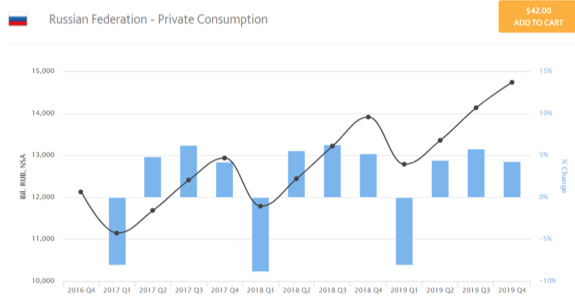
3.1.3.2 Savings
Savings:
For that indicator, The World Bank provides data for Russia from 1994 to 2018. The average value for Russia during that period was 27.8 percent with a minimum of 19.32 percent in 1998 and a maximum of 36.15 percent in 2000. The latest value from 2018 is 30.19 percent. For comparison, the world average in 2018 based on 131 countries is 22.47 percent. See the global rankings for that indicator or use the country comparative to compare trends over time.
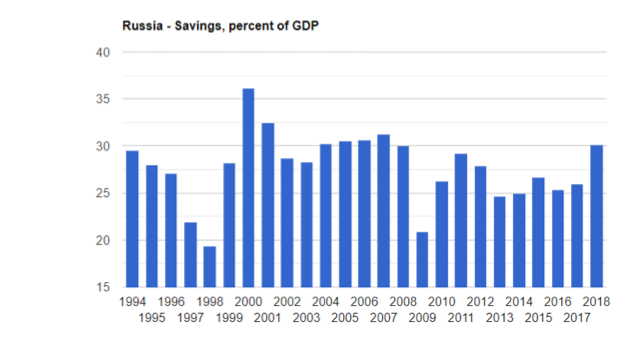
3.1.3.3 Religion
Although most Russians are Russian Orthodox and nonbelievers, religious institutions have filled the vacuum created by the downfall of communist ideology. This is potentialized by the huge restrictions that have taken place in Russian history, that relaxed only when WW2 implied the need of the support of Christians and Jews, and when in 1980 Gorbachev policies started taking place. 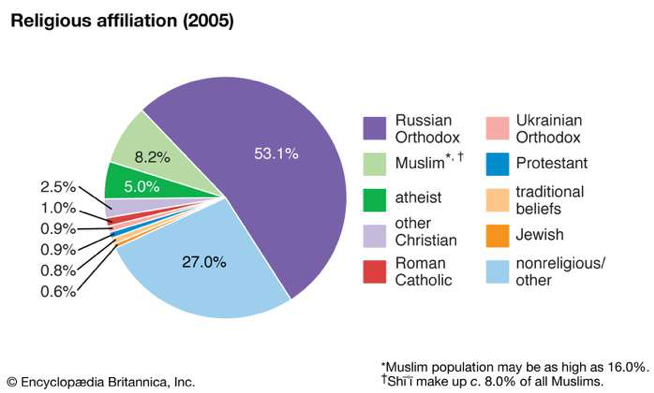
3.1.3.4 Demographics
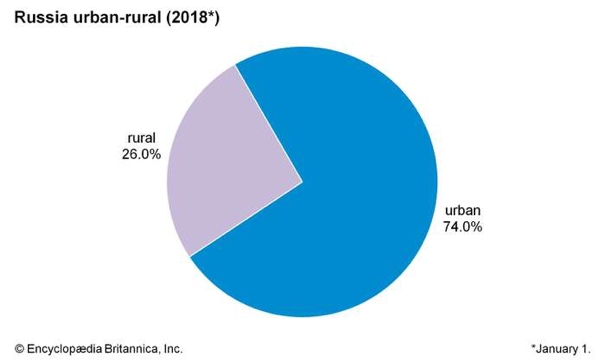
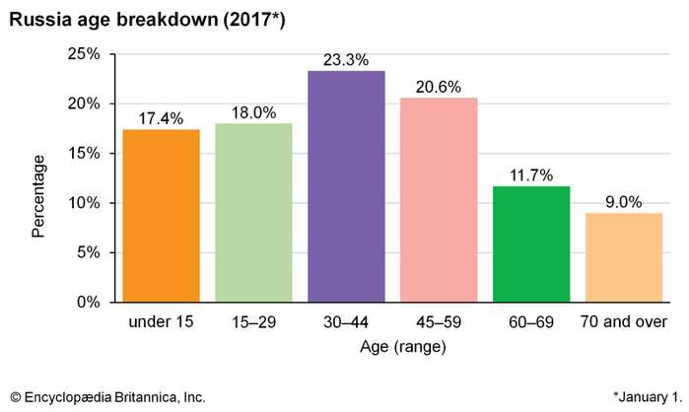
3.2 Proposals for Russia
Based on our model of growth, we propose three strategies to the Russian government in order for them to increase the development of their country. The first of these strategies is a general approach to the problem, while the other two are specific mechanisms of growth that have worked for us.
3.2.1 General proposal
Our general proposal is based on genearlized progressive institutional reforms.
Russia’s political history has been heavily marked by authoritarian governments. This situation has led to weak political and economic institutions. Although the Putin administration has not been as damaging as pre 1990s governments, it has definitively been stepping backwards in terms of institutional progress (increasing the maximum possible time in office, reducing the number of political parties that participate in elections, expropriating private companies, allowing and participating in corrupt deals and reducing the power of regional authorities).
From the World Bank “Governance Indicators” we can see how inferior Russia’s institutions are compared to Austria’s. The maximum “Average WGI” has been 1.97 and was reached by Finland in the year 2003, while the minimum was -2.45 reached by Somalia in the year 2008.

Although an institutional reform does not seem very feasible under the ruling of an authoritarian government such as Putin’s, it is the necessary step they should take in order to increase their growth. The objective of such transformation should be to re-split the legislative and administrative branches (which are currently both controlled by Putin), to reduce the size and power of the biggest corporations, to re-establish a real democracy and to reduce the power of the government on the market.
3.2.2 Specific Proposals
3.2.2.1 External Trade
Even if we only have data for the Post-Soviet Russia, we can see that the country has not been as open to trade as Austria.
Cross-border trade has been an important source of growth in Austria. Considering the benefits it has bough, we would recommend Russia to open it’s frontiers to trade as we have seen a tendency in the country to reduce its international trade. This would require, as mentioned before, a progressive institutional reform. Russia has historically been an anti-capitalist nation, and although there have been improvements in becoming a market economy the state still has a lot of influence in economic exchanges.
In 2018, trade accounted to 107.79% of Austria’s GDP while for the Russian Federation it was just 51.51% 
3.2.2.2 Small and Medium Enterprises
In Austria, Small and Medium Enterprises have been a constant and reliable source of employment and added value. They represent 99.6% of all firms, 61.8% of Value added and employ 68% of the work force (Austrian Institute for SME Research, 2019). The fact that there are so many SMEs means that there are less big corporations can influence the market, and as such, market forces prevail over pressure groups interests.
On the other hand, Russia’s economy has been known for the predomination of a small number of large firms which have control over most markets. In fact, the contributions of SMES to Russia’s GDP was only 20.2% in the year 2018 and the proportion of the workforce employed by these firms was 37.5% (Measure for St. Petersburg and Leningrad, it would be smaller if we considered the whole country).
It is thus important for Russia to consider increasing incentives and removing barriers to promote the creation on new firms. This would give Russia’s economy a lot more flexibility and it would increase market efficiency.
The Gaidar Institute (2019) has shown that in Russia, the federal budget dedicated to supporting SMES has been getting smaller every year. As we said before, this represents a step backwards, and the federal government needs to think about increasing it in following years.

3.3 Expected Outcomes
The authoritarian’s governments has always played a huge role in Russian history, even now a days the Russia government still very authoritarian even though its supposedly being a semi-presidential country, the corruption in Russia is very high according to Transparency International, Russia was ranked 137st out of 180 countries in its corruption perception index, calculate the cost of corruption in the economy is very difficult some conservative governments put the cost of corruption at 2.5 billion between 2014 and 2017.
Also there is an estimation that the bribes, extortion and kickbacks adds between 5% and 15% to the cost of goods and services; small entrepreneurs spend a minimum US$ 500 million monthly on bribes to officials and as we mention small and medium enterprises should have bigger role in Russia economy, so this spend in bribes damage a lot the small and medium enterprises that are the ones that employed almost 40% of the labor force in St Petersburg and Leningrad, so the government must protect and support them. The value of export and imports of goods and services is around 51.5 of the GDP, the average tariffs applied is around 3.6% without counting the bureaucratic barriers that distort the flow of good and services.
This corruption and bureaucracy affects severely the development of the country, the fiscal revenue, the market efficiency, inflation, flow of goods and services and many other sectors of Russia economy so as we mention in the suggestion a progressive institutional and cultural is the most important change and it would be very beneficial, but this would take time because corruption is very established in Russia institutions and culture, so we estimated that this progressive change would lead to an small growth in the first five years around 0.5% of the GDP, the next five years around 1% of the GDP and in the next 10 years around 2.5% pf the GPD (Levin & Satarov, 2000).
From this analysis, we can conclude that an institutional transformation that affects government structure and the economic system will be translated in a reduction of the burden of corruption, which could be translated into more investment from the authorities. It would also contribute to reducing the price of goods, which would increase the purchasing power of individuals, thus increasing their life quality. Finally, as corruption is reduced and incentives to the creation of enterprises are established, the nation will see an increase in SMEs that will bring more growth, innovation and flexibility to the Russian Economic System.
References
- Austrian Institute for SME Research. (2019). SME DATA. Retrieved form https://www.kmuforschung.ac.at/facts-and-figures/kmu-daten/?lang=en. Accessed on 16 April 2020
- Gaidar Institute. (2019). Russian Economy in 2018. Trends and Outlooks. (Issue 40).
- Kardashov, A. (2020). Russia’s Small Businesses Contribute Just 20% of Economy. The Moscow Times. Retrieved form https://www.themoscowtimes.com/2020/01/28/russias-small-businesses-contribute-20-percent-russia-economy-a69063 on April 16, 2020.
- Maynes, C. (2020). New Reports Highlight Russia’s Deep-Seated Culture of Corruption. Voanews. Retrieved from https://www.voanews.com/europe/new-reports-highlight-russias-deep-seated-culture-corruption on April 20, 2020
- Levin, M., & Satarov, G. (2000). Corruption and institutions in Russia. European journal of political economy, 16(1), 113-132.
- Hosking, G.,A. (2020). Russia. In Encyclopedia Britannica. Retrieved from https://www.britannica.com/place/Russia